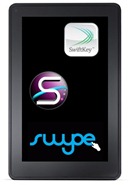Install Alternate Keyboard Apps On Kindle Fire [How To]

The option to choose your input method in the Kindle Fire, has been omitted but credit to PSXtreme and mfisch as well for figuring out a way around this. So let’s get you started, and help you with getting an alternate keyboard up and running on your Kindle Fire. The trick involves editing a few values depending on the keyboard you’re installing. So far this a list of known values for various keyboard apps:
- Swiftkey (paid version): com.touchtype.swiftkey/com.touchtype.KeyboardService
- Swiftkey Tablet (paid version): com.touchtype.swiftkey.tablet.full/com.touchtype.KeyboardService
- Swype: com.swype.android.inputmethod/.SwypeInputMethod
- SymbolsKeyboard & TextArt Pro: com.mobisters.textart.pro/.AsciiTextArtKeyboardPro
- SlideIT: com.dasur.slideit/.SlideITIME
- Graffiti Pro: com.access_company.graffiti_pro/.Graffiti
- FlexT9: com.nuance.flext9.input/.IME
- Beansoft Thumb Keyboard: com.beansoft.keyboardplus/.LatinIME
- Hacker’s Keyboard: org.pocketworkstation.pckeyboard/.LatinIME
- Simeji: com.adamrocker.android.input.simeji/.OpenWnnSimeji
Disclaimer: Please follow this guide at your own risk. AddictiveTips will not be liable if your device gets damaged or bricked during the process.
Requirements:
- A rooted Kindle Fire. See our guide on rooting the Kindle Fire.
- Android Market and Google Apps installed. See our guide on installing Android Market and Google Apps on the Kindle Fire.
- SQLite Database Browser.
Instructions:
- Make sure USB Debugging in enabled on your device, and connect it to the PC.
- When the device tells you that USB Storage is enabled, disable it.
- Open command prompt and enter the following commands:
adb shell
su
cd /data/data/
com.android.providers.settings/databases
cp settings.db settings.db.bak
cp settings.db /mnt/sdcard/Download
- Now enable USB Storage on the Kindle Fire from within the notification bar.
- Run the SQLite Browser you downloaded, and browse to the Download folder on your Kindle Fire to open the settings.db file.
- Click the the Browse Data tab in SQLite and then secure from the drop list of tables.
- Find the row with the entry named enabled_input_methods.
- Double click on this entry to open up an Edit database cell dialog.
- The default value of the entry should be com.android.inputmethod.latin/.LatinIME
- So, if for example you’re installing the SwiftKey paid app, you need to add the following string after the default entry: :com.touchtype.swiftkey/.KeyboardService
- In effect the end result should look like this: com.android.inputmethod.latin/.LatinIME:com.touchtype.swiftkey/com.touchtype.KeyboardService
- When done, hit the Apply Changes button, close the dialog, and save your changes tro the settings.db file. Close the SQLite browser.
- Disable USB Storage mode on the Kindle Fire.
- Open command prompt once again and enter the following commands (Very important, do NOT skip!):
adb shell
su
cp /mnt/sdcard/Download/settings.db
chown system.system settings.*
chmod 660 settings.*
ls -l
reboot
Once the Kindle Fire reboots, you can proceed with the keyboard installation of your choice. Once installed, long-press on a text field to bring up the Select input method menu to choose from the Kindle Fire’s keyboard or the one you installed.
For updates and queries, head over to the forum thread at XDA-Developers.

http://forum.xda-developers.com/showthread.php?t=1364543
my pc says :
‘adb’ is not recognized as an internal or external command,
operable program or batch file.
where did i go wrong?
The Author neglected to mention that you need adb to do this:
http://developer.android.com/guide/developing/tools/adb.html
Thanks these instructions worked great. I was able to get the PhatWare WritePad handwriting recognition software to work. Here’s the entry I used:
:com.phatware.writepad/.InputPanel
Thanks for your instruction. I’m now stuck at the 2nd part. I couldn’t do “cp /mnt/sdcard/download/settings.db”
That’s a huge typo and I’m surprised it’s still there. That command does nothing. I presume he meant (note spacing and “punctuation”)
cp /mnt/sdcard/download/settings.db .
or perhaps
cp /mnt/sdcard/download/settings.db /data/data/com.android.providers.settings/databases
i’m stuck at #3. i’ve opened up a cmd prompt on my computer but where do i enter in those commands?
tkoo it will say something like
c:userstykoo> you type the commands immediately after so it will look like this:
c:userstykoo>adb shell> then you hit enter and it wil populate the rest of the commands for you. You just hit eter, wait for the it to generate and enter the next command right after the “>” at the end of each line.
Hope that helps! Let me know if this method works!
I am despairing at the part where I have to enable USB Debugging. I cannot find this mystical file “~/.android/adb_usb.ini” that I am supposed to do a tiny little addition to in a text editor to to get USB Debugging working. I think I can handle everything else but finding this file has defeated me
.android is a hidden folder. either enable AppleShowAllFiles or use the command/shift/G to go directly to the location mentioned.